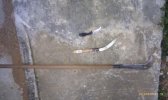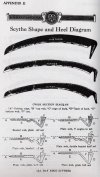- Joined
- Jan 13, 2011
- Messages
- 2,562
Looks like an old Seymour snath. I imagine their current replacement nibs would still fit that one. Just use a wire brush to clean up the rusty fittings and then soak the crap out of them with penetrating oil to loosen it all up and get moving parts working again. You'll also want to oil the crap out of the snath so it won't be so brittle from having dried out. Nice snag though--that blade looks to have a very nice shape to it!
Thanks, 42. I was hoping to spend some time on it today, but other things got in the way. Maybe tomorrow. I hope the snath comes out okay. There are a couple places with some grain separation near the outside edges. It's WAY dried out.
I spent the fall playing with scythes, got a sweet little 12" brush blade for my American scythe. That thing eats reeds/goldenrod/small trees like candy. A neighbor of mine also dropped by with his euro scythe lamenting my "obsolete" American scythe. I tried it, and frankly hated it. Too light, I felt like I was doing twice as much work and if I took any off the swing it would stop cutting. The heavier tool does more work if you know how to use it. The only advantage the euro had was in short grass, but since I do not employ that method of grass maintenance I don't care for them.
I feel like you just rained on my parade.





